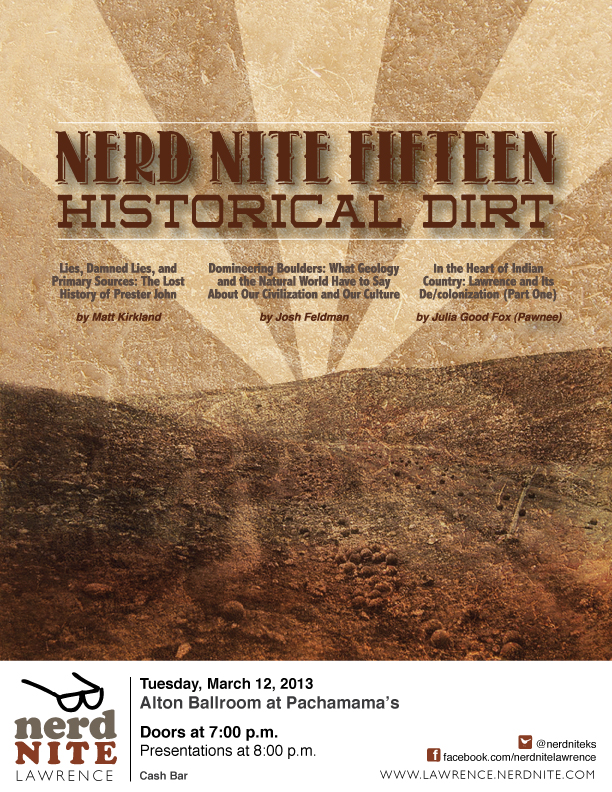we’ll look at the Lawrence region’s history of de/colonization, the centuries long myth of Prester John that propelled the spice trade and the Crusades, and how the dirt and rocks beneath our feet have influenced history.
TUESDAY, March 12, 2013.
Doors at 7, Presentations at 8.
At Pachamama’s Alton Ballroom (8th and NH)
featuring:
Lies, Damned Lies, and Primary Sources: The Lost History of Prester John by Matt Kirkland
For centuries, medieval Europeans believed rumors of a fantastical Christian kingdom in the Far East, ruled by an immortal priest-king named Prester John. The West sent him letters, envoys, and explorers – and even got letters in return. So where did this wild story come from? And why did everybody believe it? And why have we forgotten about him today? Matt Kirkland will explore the strange pseudo-history of Prester John.
Matt Kirkland just moved back to Lawrence after exiles in Hong Kong and San Diego. He designs for the web at Brand New Box, a web development firm downtown. He spends free time drinking whisky and playing outside. While not even an amateur historian, he definitely reads more than is good for him.
In the Heart of Indian Country: Lawrence and Its De/colonization (Part One)
by Julia Good Fox (Pawnee), Writer and American Indian Studies Instructor
Before the arrival of the abolitionists, the area now known as Lawrence was in the territory of different Tribes—including at one point, the Pawnee Nation. Our town was established during the time of colonialism, and nearly 160 years later, Lawrence continues to mirror the intricate relationship between Indian Country and the United States. Yet our town also offers its own unique documentation of this political and cultural connection. Using the 1884 founding of the Haskell Indian Institute as our starting point, let’s begin to explore the collective history of Tribal and non-Tribal Peoples through our architecture, sports, and art.
Domineering Boulders: What Geology and the Natural World Have to Say About Our Civilization and Our Culture by Josh Feldman
Humanity has been intimately bound to the rocks around them since before the first homo sapien was a glimmer in a young chimps eye. We will explore how local geology has impacted ancient civilizations, from their technology to their architecture to their trade and politics, and then we’ll look at how these same themes continue to run through our lives today. Let’s travel through our past, from the Parthenon to the Pantheon to the Pentagon, and try to understand the Earth around us.
Josh Feldman is a volcanologist that dates rocks, but he knows shamefully little about Spock and hasn’t been to a movie with a limestone in ages. He manages the Isotope Geochemistry Laboratories at KU, which is basically an excuse to dress in a lab coat and pour acids into different shaped containers and shoot things with lasers. While he’s always wanted to be a lab-coat wearing scientist, he picked geology because he loves hiking and camping. When there’s too much snow to hike and camp he likes to cook for his friends.
